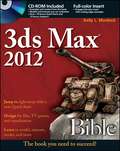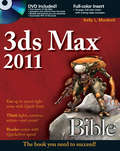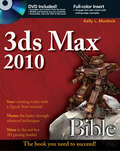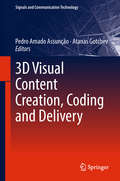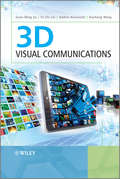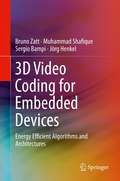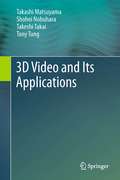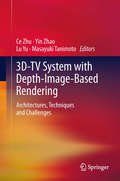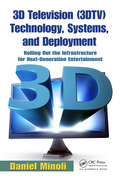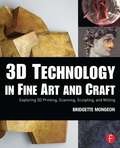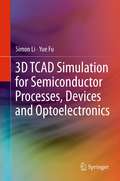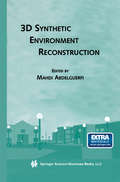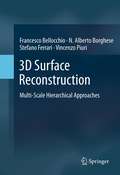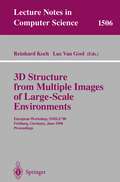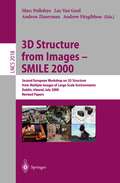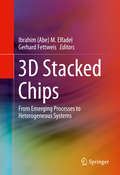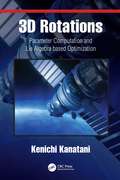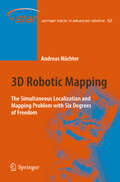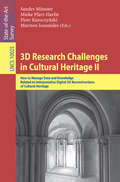- Table View
- List View
3ds Max 2012 (PDF)
by Kelly MurdockUpdated version of the bestselling 3ds Max book on the market 3ds Max 2012 Bible is one of the most popular 3ds Max how-tos on the market. If you're a beginner just itching to create something right away, the Quick Start project in Part 1 is for you. If you're an experienced user checking out 3ds Max 2012's latest and greatest features, you'll love the fact that the 3ds Max 2012 Bible continues to be the most comprehensive reference on this highly complex application. Find out what's new, what's tried and true, and how creative you can get using the tips, tricks, and techniques in this must-have guide. Don't miss the 16-page color insert with examples from cutting-edge 3D artists, as well as the DVD packed with all kinds of extras. Loaded with expert advice, timesaving tips, and more than 150 step-by-step tutorials Highlights the work of some of today's most cutting-edge 3D artists in a 16-page color insert Includes a companion DVD with all examples from the book, including unique models and texture that you can customize DVD also features 500 pages of extra content from previous editions of the 3ds Max Bible, including a set of Quick Start tutorials If you want to gain 3ds Max 2012 skills, whether you're just beginning or not, this is the book you need to succeed.
3ds Max 2011 Bible (Bible #719)
by Kelly L. MurdockUpdated version of the bestselling 3ds Max book on the market Used by more than 150,000 people, and the winner of more than 65 industry awards, 3ds Max is the world's most popular animation modeling and rendering software for film, television, video games, and design visualization. 3ds Max Bible is the world’s most popular book for getting the most out of the software. Whether a novice looking to create something immediately using the Quick Start tutorial, or an experienced 3ds Max user who simply wants to check out the software's latest and greatest features, this update to the bestselling 3ds Max book on the market continues to be the most comprehensive reference on this highly complex application. Packed with expert advice, timesaving tips, and more than 150 step-by-step tutorials 16-page color insert highlights the work of some of today’s most cutting-edge 3D artists Includes a companion DVD with a searchable, full-color version of the 3ds Max Bible, as well as customizable models and textures The only comprehensive reference-tutorial on 3ds Max, it's no wonder the 3ds Max Bible is the bestselling 3ds Max book in the world and a favorite of both amateur and professional animators. Note: CD-ROM/DVD and other supplementary materials are not included as part of eBook file.
3ds Max 2011 Bible (Bible #674)
by Kelly L. MurdockUpdated version of the bestselling 3ds Max book on the market Used by more than 150,000 people, and the winner of more than 65 industry awards, 3ds Max is the world's most popular animation modeling and rendering software for film, television, video games, and design visualization. 3ds Max Bible is the world’s most popular book for getting the most out of the software. Whether a novice looking to create something immediately using the Quick Start tutorial, or an experienced 3ds Max user who simply wants to check out the software's latest and greatest features, this update to the bestselling 3ds Max book on the market continues to be the most comprehensive reference on this highly complex application. Packed with expert advice, timesaving tips, and more than 150 step-by-step tutorials 16-page color insert highlights the work of some of today’s most cutting-edge 3D artists Includes a companion DVD with a searchable, full-color version of the 3ds Max Bible, as well as customizable models and textures The only comprehensive reference-tutorial on 3ds Max, it's no wonder the 3ds Max Bible is the bestselling 3ds Max book in the world and a favorite of both amateur and professional animators. Note: CD-ROM/DVD and other supplementary materials are not included as part of eBook file.
3ds Max 2010 Bible (Bible #590)
by Kelly L. MurdockThe bestselling 3ds Max book ever, now updated for the latest version 3ds Max is the world's most popular animation modeling and rendering software used to create 80 percent of commercially available video games, including those for Microsoft's Xbox 360, Sony's Playstation 3, and Nintendo's Wii. It is an expensive, intricate program that can take years to thoroughly master. As the ultimate comprehensive reference and tutorial on 3ds Max, this guide contains in-depth coverage of every aspect of 3ds Max and explores the newest features that the latest version has to offer. You'll learn to master the complexities of 3ds Max under the guidance of 3D expert Kelly Murdock. Includes in-depth detail on all the latest features for veterans of earlier versions of 3ds Max from 3D expert Kelly Murdock Shares expert advice, timesaving techniques, and more than 150 step-by-step tutorials Features a 16-page, full-color insert with inspiring examples of cutting-edge 3ds Max art Bonus DVD contains all the examples from the book, unique models and textures that you can customize on your own, and a searchable, full-color version of the book A Quick Start chapter shows you how to create an exciting animation on your very first day with the software so you can dive in and get started immediately. Note: CD-ROM/DVD and other supplementary materials are not included as part of eBook file.
3ds Max 2010 Bible (Bible #590)
by Kelly L. MurdockThe bestselling 3ds Max book ever, now updated for the latest version 3ds Max is the world's most popular animation modeling and rendering software used to create 80 percent of commercially available video games, including those for Microsoft's Xbox 360, Sony's Playstation 3, and Nintendo's Wii. It is an expensive, intricate program that can take years to thoroughly master. As the ultimate comprehensive reference and tutorial on 3ds Max, this guide contains in-depth coverage of every aspect of 3ds Max and explores the newest features that the latest version has to offer. You'll learn to master the complexities of 3ds Max under the guidance of 3D expert Kelly Murdock. Includes in-depth detail on all the latest features for veterans of earlier versions of 3ds Max from 3D expert Kelly Murdock Shares expert advice, timesaving techniques, and more than 150 step-by-step tutorials Features a 16-page, full-color insert with inspiring examples of cutting-edge 3ds Max art Bonus DVD contains all the examples from the book, unique models and textures that you can customize on your own, and a searchable, full-color version of the book A Quick Start chapter shows you how to create an exciting animation on your very first day with the software so you can dive in and get started immediately. Note: CD-ROM/DVD and other supplementary materials are not included as part of eBook file.
3D Visual Content Creation, Coding and Delivery (Signals and Communication Technology)
by Pedro Amado Assunção Atanas GotchevThis book covers the different aspects of modern 3D multimedia technologies by addressing several elements of 3D visual communications systems, using diverse content formats, such as stereo video, video-plus-depth and multiview, and coding schemes for delivery over networks. It also presents the latest advances and research results in regards to objective and subjective quality evaluation of 3D visual content, extending the human factors affecting the perception of quality to emotional states. The contributors describe technological developments in 3D visual communications, with particular emphasis on state-of-the-art advances in acquisition of 3D visual scenes and emerging 3D visual representation formats, such as: multi-view plus depth and light field;evolution to freeview and light-field representation;compression methods and robust delivery systems; andcoding and delivery over various channels. Simulation tools, testbeds and datasets that are useful for advanced research and experimental studies in the field of 3D multimedia delivery services and applications are covered. The international group of contributors also explore the research problems and challenges in the field of immersive visual communications, in order to identify research directions with substantial economic and social impact. 3D Visual Content Creation, Coding and Delivery provides valuable information to engineers and computer scientists developing novel products and services with emerging 3D multimedia technologies, by discussing the advantages and current limitations that need to be addressed in order to develop their products further. It will also be of interest to students and researchers in the field of multimedia services and applications, who are particularly interested in advances bringing significant potential impact on future technological developments.
3D Visual Communications
by Guan-Ming Su Yu-chi Lai Andres Kwasinski Haohong WangProvides coverage of the major theories and technologies involved in the lifecycle of 3D video content delivery Presenting the technologies used in end-to-end 3D video communication systems, this reference covers 3D graphics and video coding, content creation and display, and communications and networking. It covers the full range of key areas from the fundamentals of 3D visual representation to the latest 3D video coding techniques, relevant communication infrastructure and networks to the 3D quality of experience. The book is structured to logically lead readers through the topic, starting with generic and fundamental information, continuing with a detailed section of different visualisation techniques before concluding with an extensive view of 3D mobile communication systems and trends. The authors give most focus to four important areas: 3D video coding and communications; 3D graphics/gaming and mobile communications; end-to-end 3D ecosystem (including 3D display, 3D player, networking facility and 3D quality issues), and future communications and networks advances for emerging 3D experience. Presents the theory and key concepts behind the latest 3D visual coding framework, standards, and corresponding quality assessment Provides fundamental material which forms the basis for future research on enhancing the performance of 3D visual communications over current and future wireless networks Covers important topics including: 3D video coding and communications; 3D graphics/gaming and mobile communications; end-to-end 3D ecosystem; and future communications and networks advances for emerging 3D experience Essential reading for engineers involved in the research, design and development of 3D visual coding and 3D visual transmission systems and technologies, as well as academic and industrial researchers.
3D Visual Communications
by Guan-Ming Su Yu-chi Lai Andres Kwasinski Haohong WangProvides coverage of the major theories and technologies involved in the lifecycle of 3D video content delivery Presenting the technologies used in end-to-end 3D video communication systems, this reference covers 3D graphics and video coding, content creation and display, and communications and networking. It covers the full range of key areas from the fundamentals of 3D visual representation to the latest 3D video coding techniques, relevant communication infrastructure and networks to the 3D quality of experience. The book is structured to logically lead readers through the topic, starting with generic and fundamental information, continuing with a detailed section of different visualisation techniques before concluding with an extensive view of 3D mobile communication systems and trends. The authors give most focus to four important areas: 3D video coding and communications; 3D graphics/gaming and mobile communications; end-to-end 3D ecosystem (including 3D display, 3D player, networking facility and 3D quality issues), and future communications and networks advances for emerging 3D experience. Presents the theory and key concepts behind the latest 3D visual coding framework, standards, and corresponding quality assessment Provides fundamental material which forms the basis for future research on enhancing the performance of 3D visual communications over current and future wireless networks Covers important topics including: 3D video coding and communications; 3D graphics/gaming and mobile communications; end-to-end 3D ecosystem; and future communications and networks advances for emerging 3D experience Essential reading for engineers involved in the research, design and development of 3D visual coding and 3D visual transmission systems and technologies, as well as academic and industrial researchers.
3D Video Coding for Embedded Devices: Energy Efficient Algorithms and Architectures
by Bruno Zatt Muhammad Shafique Sergio Bampi Jörg HenkelThis book shows readers how to develop energy-efficient algorithms and hardware architectures to enable high-definition 3D video coding on resource-constrained embedded devices. Users of the Multiview Video Coding (MVC) standard face the challenge of exploiting its 3D video-specific coding tools for increasing compression efficiency at the cost of increasing computational complexity and, consequently, the energy consumption. This book enables readers to reduce the multiview video coding energy consumption through jointly considering the algorithmic and architectural levels. Coverage includes an introduction to 3D videos and an extensive discussion of the current state-of-the-art of 3D video coding, as well as energy-efficient algorithms for 3D video coding and energy-efficient hardware architecture for 3D video coding.
3D Video and Its Applications
by Takashi Matsuyama Shohei Nobuhara Takeshi Takai Tony TungThis book presents a broad review of state-of-the-art 3D video production technologies and applications. The text opens with a concise introduction to the field, before examining the design and calibration methods for multi-view camera systems, including practical implementation technologies. A range of algorithms are then described for producing 3D video from video data. A selection of 3D video applications are also demonstrated. Features: describes real-time synchronized multi-view video capture, and object tracking with a group of active cameras; discusses geometric and photometric camera calibration, and 3D video studio design with active cameras; examines 3D shape and motion reconstruction, texture mapping and image rendering, and lighting environment estimation; demonstrates attractive 3D visualization, visual contents analysis and editing, 3D body action analysis, and data compression; highlights the remaining challenges and the exciting avenues for future research in 3D video technology.
3D-TV System with Depth-Image-Based Rendering: Architectures, Techniques and Challenges
by Ce Zhu, Yin Zhao, Lu Yu and Masayuki TanimotoRiding on the success of 3D cinema blockbusters and advances in stereoscopic display technology, 3D video applications have gathered momentum in recent years. 3D-TV System with Depth-Image-Based Rendering: Architectures, Techniques and Challenges surveys depth-image-based 3D-TV systems, which are expected to be put into applications in the near future. Depth-image-based rendering (DIBR) significantly enhances the 3D visual experience compared to stereoscopic systems currently in use. DIBR techniques make it possible to generate additional viewpoints using 3D warping techniques to adjust the perceived depth of stereoscopic videos and provide for auto-stereoscopic displays that do not require glasses for viewing the 3D image. The material includes a technical review and literature survey of components and complete systems, solutions for technical issues, and implementation of prototypes. The book is organized into four sections: System Overview, Content Generation, Data Compression and Transmission, and 3D Visualization and Quality Assessment. This book will benefit researchers, developers, engineers, and innovators, as well as advanced undergraduate and graduate students working in relevant areas.
3D Television (3DTV) Technology, Systems, and Deployment: Rolling Out the Infrastructure for Next-Generation Entertainment
by Daniel MinoliGoing beyond the technological building blocks of 3DTV, 3D Television (3DTV) Technology, Systems, and Deployment: Rolling Out the Infrastructure for Next-Generation Entertainment offers an early view of the deployment and rollout strategies of this emerging technology. It covers cutting-edge advances, theories, and techniques in end-to-end 3DTV sys
3D Technology in Fine Art and Craft: Exploring 3D Printing, Scanning, Sculpting and Milling
by Bridgette MongeonThe possibilities for creation are endless with 3D printing, sculpting, scanning, and milling, and new opportunities are popping up faster than artists can keep up with them. 3D Technology in Fine Art and Craft takes the mystery out of these exciting new processes by demonstrating how to navigate their digital components and showing their real world applications. Artists will learn to incorporate these new technologies into their studio work and see their creations come to life in a physical form never before possible. Featuring a primer on 3D basics for beginners,interviews, tutorials, and artwork from over 80 artists, intellectual property rights information, and a comprehensive companion website, this book is your field guide to exploring the exhilarating new world of 3D. Follow step-by-step photos and tutorials outlining the techniques, methodologies, and finished products of master artists who have employed 3D technology in new and inventive ways Learn how to enlarge, reduce, and repurpose existing artwork and create virtual pieces in physical forms through a variety of mediums Research your options with an accessible list of pros and cons of the various software, 3D printers, scanners, milling machines, and vendors that provide services in 3D technology Listen to podcasts with the artists and learn more tips and tricks through the book's website at www.digitalsculpting.net
3D Technology in Fine Art and Craft: Exploring 3D Printing, Scanning, Sculpting and Milling
by Bridgette MongeonThe possibilities for creation are endless with 3D printing, sculpting, scanning, and milling, and new opportunities are popping up faster than artists can keep up with them. 3D Technology in Fine Art and Craft takes the mystery out of these exciting new processes by demonstrating how to navigate their digital components and showing their real world applications. Artists will learn to incorporate these new technologies into their studio work and see their creations come to life in a physical form never before possible. Featuring a primer on 3D basics for beginners,interviews, tutorials, and artwork from over 80 artists, intellectual property rights information, and a comprehensive companion website, this book is your field guide to exploring the exhilarating new world of 3D. Follow step-by-step photos and tutorials outlining the techniques, methodologies, and finished products of master artists who have employed 3D technology in new and inventive ways Learn how to enlarge, reduce, and repurpose existing artwork and create virtual pieces in physical forms through a variety of mediums Research your options with an accessible list of pros and cons of the various software, 3D printers, scanners, milling machines, and vendors that provide services in 3D technology Listen to podcasts with the artists and learn more tips and tricks through the book's website at www.digitalsculpting.net
3D TCAD Simulation for Semiconductor Processes, Devices and Optoelectronics
by Simon Li Suihua LiTechnology computer-aided design, or TCAD, is critical to today’s semiconductor technology and anybody working in this industry needs to know something about TCAD. This book is about how to use computer software to manufacture and test virtually semiconductor devices in 3D. It brings to life the topic of semiconductor device physics, with a hands-on, tutorial approach that de-emphasizes abstract physics and equations and emphasizes real practice and extensive illustrations. Coverage includes a comprehensive library of devices, representing the state of the art technology, such as SuperJunction LDMOS, GaN LED devices, etc.
3D Synthetic Environment Reconstruction (The Springer International Series in Engineering and Computer Science #611)
by Mahdi AbdelguerfiAlthough synthetic environments were traditionally used in military settings for mission rehearsal and simulations, their use is rapidly spreading to a variety of applications in the commercial, research and industrial sectors, such as flight training for commercial aircraft, city planning, car safety research in real-time traffic simulations, and video games. 3D Synthetic Environment Reconstruction contains seven invited chapters from leading experts in the field, bringing together a coherent body of recent knowledge relating 3D geospatial data collection, design issues, and techniques used in synthetic environments design, implementation and interoperability. In particular, this book describes new techniques for the generation of Synthetic Environments with increased resolution and rich attribution, both essential for accurate modeling and simulation. This book also deals with interoperability of models and simulations, which is necessary for facilitating the reuse of modeling and simulation components.3D Synthetic Environment Reconstruction is an excellent reference for researchers and practitioners in the field.
3D Surface Reconstruction: Multi-Scale Hierarchical Approaches
by Francesco Bellocchio N. Alberto Borghese Stefano Ferrari Vincenzo Piuri3D Surface Reconstruction: Multi-Scale Hierarchical Approaches presents methods to model 3D objects in an incremental way so as to capture more finer details at each step. The configuration of the model parameters, the rationale and solutions are described and discussed in detail so the reader has a strong understanding of the methodology. Modeling starts from data captured by 3D digitizers and makes the process even more clear and engaging. Innovative approaches, based on two popular machine learning paradigms, namely Radial Basis Functions and the Support Vector Machines, are also introduced. These paradigms are innovatively extended to a multi-scale incremental structure, based on a hierarchical scheme. The resulting approaches allow readers to achieve high accuracy with limited computational complexity, and makes the approaches appropriate for online, real-time operation. Applications can be found in any domain in which regression is required. 3D Surface Reconstruction: Multi-Scale Hierarchical Approaches is designed as a secondary text book or reference for advanced-level students and researchers in computer science. This book also targets practitioners working in computer vision or machine learning related fields.
3D Structure from Multiple Images of Large-Scale Environments: European Workshop, SMILE'98, Freiburg, Germany, June 6-7, 1998, Proceedings (Lecture Notes in Computer Science #1506)
by Reinhard Koch Luc Van Gool3D Structure from Images - SMILE 2000: Second European Workshop on 3D Structure from Multiple Images of Large-Scale Environments Dublin, Ireland, July 12, 2000, Revised Papers (Lecture Notes in Computer Science #2018)
by Marc Pollefeys Luc Van Gool Andrew Zisserman Andrew FitzgibbonThis volume contains the ?nal version of the papers originally presented at the second SMILE workshop 3D Structure from Multiple Images of Large-scale Environments, which was held on 1-2 July 2000 in conjunction with the Sixth European Conference in Computer Vision at Trinity College Dublin. The subject of the workshop was the visual acquisition of models of the 3D world from images and their application to virtual and augmented reality. Over the last few years tremendous progress has been made in this area. On the one hand important new insightshavebeenobtainedresultinginmore exibilityandnewrepresentations.Onthe other hand a number of techniques have come to maturity, yielding robust algorithms delivering good results on real image data. Moreover supporting technologies – such as digital cameras, computers, disk storage, and visualization devices – have made things possible that were infeasible just a few years ago. Opening the workshop was Paul Debevec s invited presentation on image-based modeling,rendering,andlighting.Hepresentedanumberoftechniquesforusingdigital images of real scenes to create 3D models, virtual camera moves, and realistic computer animations.Theremainderoftheworkshopwasdividedintothreesessions:Computation and Algorithms, Visual Scene Representations, and Extended Environments. After each session there was a panel discussion that included all speakers. These panel discussions were organized by Bill Triggs, Marc Pollefeys, and Tomas Pajdla respectively, who introduced the topics and moderated the discussion. Asubstantialpartoftheseproceedingsarethetranscriptsofthediscussionsfollowing each paper and the full panel sessions. These discussions were of very high quality and were an integral part of the workshop.
3D Stacked Chips: From Emerging Processes to Heterogeneous Systems
by Ibrahim Abe M. Elfadel Gerhard FettweisThis book explains for readers how 3D chip stacks promise to increase the level of on-chip integration, and to design new heterogeneous semiconductor devices that combine chips of different integration technologies (incl. sensors) in a single package of the smallest possible size. The authors focus on heterogeneous 3D integration, addressing some of the most important challenges in this emerging technology, including contactless, optics-based, and carbon-nanotube-based 3D integration, as well as signal-integrity and thermal management issues in copper-based 3D integration. Coverage also includes the 3D heterogeneous integration of power sources, photonic devices, and non-volatile memories based on new materials systems.
3D Rotations: Parameter Computation and Lie Algebra based Optimization
by Kenichi Kanatani3D rotation analysis is widely encountered in everyday problems thanks to the development of computers. Sensing 3D using cameras and sensors, analyzing and modeling 3D for computer vision and computer graphics, and controlling and simulating robot motion all require 3D rotation computation. This book focuses on the computational analysis of 3D rotation, rather than classical motion analysis. It regards noise as random variables and models their probability distributions. It also pursues statistically optimal computation for maximizing the expected accuracy, as is typical of nonlinear optimization. All concepts are illustrated using computer vision applications as examples. Mathematically, the set of all 3D rotations forms a group denoted by SO(3). Exploiting this group property, we obtain an optimal solution analytical or numerically, depending on the problem. Our numerical scheme, which we call the "Lie algebra method," is based on the Lie group structure of SO(3). This book also proposes computing projects for readers who want to code the theories presented in this book, describing necessary 3D simulation setting as well as providing real GPS 3D measurement data. To help readers not very familiar with abstract mathematics, a brief overview of quaternion algebra, matrix analysis, Lie groups, and Lie algebras is provided as Appendix at the end of the volume.
3D Rotations: Parameter Computation and Lie Algebra based Optimization
by Kenichi Kanatani3D rotation analysis is widely encountered in everyday problems thanks to the development of computers. Sensing 3D using cameras and sensors, analyzing and modeling 3D for computer vision and computer graphics, and controlling and simulating robot motion all require 3D rotation computation. This book focuses on the computational analysis of 3D rotation, rather than classical motion analysis. It regards noise as random variables and models their probability distributions. It also pursues statistically optimal computation for maximizing the expected accuracy, as is typical of nonlinear optimization. All concepts are illustrated using computer vision applications as examples. Mathematically, the set of all 3D rotations forms a group denoted by SO(3). Exploiting this group property, we obtain an optimal solution analytical or numerically, depending on the problem. Our numerical scheme, which we call the "Lie algebra method," is based on the Lie group structure of SO(3). This book also proposes computing projects for readers who want to code the theories presented in this book, describing necessary 3D simulation setting as well as providing real GPS 3D measurement data. To help readers not very familiar with abstract mathematics, a brief overview of quaternion algebra, matrix analysis, Lie groups, and Lie algebras is provided as Appendix at the end of the volume.
3D Robotic Mapping: The Simultaneous Localization and Mapping Problem with Six Degrees of Freedom (Springer Tracts in Advanced Robotics #52)
by Andreas NüchterFocuses on acquiring spatial models of physical environments through mobile robots The robotic mapping problem is commonly referred to as SLAM (simultaneous localization and mapping). 3D maps are necessary to avoid collisions with complex obstacles and to self-localize in six degrees of freedom (x-, y-, z-position, roll, yaw and pitch angle) New solutions to the 6D SLAM problem for 3D laser scans are proposed and a wide variety of applications are presented
3D Research Challenges in Cultural Heritage III: Complexity and Quality in Digitisation (Lecture Notes in Computer Science #13125)
by Marinos Ioannides Petros PatiasThis open access book presents a collection of papers focusing on current 3D research challenges in the domain of digital cultural heritage. 3D technologies find considerable use within the field of cultural heritage at the beginning of the 21st century, for example in the areas of data acquisition, modeling, archiving in local repositories, harvesting in digital libraries and their long-term preservation. This volume put emphasis on a number of challenges facing 3D research in the 2D/3D digitization of tangible objects and their transformation to digital/virtual/memory twins; the interplay of geometry, semantics and the recovery and management of knowledge in digital cultural heritage; the handling of 3D data via the Cloud on the Internet and mobile devices; the presentation of cultural heritage content in 3D to the general public; and the 3D reproduction of cultural heritage objects from virtual to real.
3D Research Challenges in Cultural Heritage II: How to Manage Data and Knowledge Related to Interpretative Digital 3D Reconstructions of Cultural Heritage (Lecture Notes in Computer Science #10025)
by Sander Münster Mieke Pfarr-Harfst Piotr Kuroczyński Marinos IoannidesThis book reflects a current state of the art and future perspectives of Digital Heritage focusing on not interpretative reconstruction and including as well as bridging practical and theoretical perspectives, strategies and approaches. Comprehensive key challenges are related to knowledge transfer and management as well as data handling within a interpretative digital reconstruction of Cultural Heritage including aspects of digital object creation, sustainability, accessibility, documentation, presentation, preservation and more general scientific compatibility. The three parts of the book provide an overview of a scope of usage scenarios, a current state of infrastructures as digital libraries, information repositories for an interpretative reconstruction of Cultural Heritage; highlight strategies, practices and principles currently used to ensure compatibility, reusability and sustainability of data objects and related knowledge within a 3D reconstruction work process on a day to day work basis; and show innovative concepts for the exchange, publishing and management of 3D objects and for inherit knowledge about data, workflows and semantic structures.
